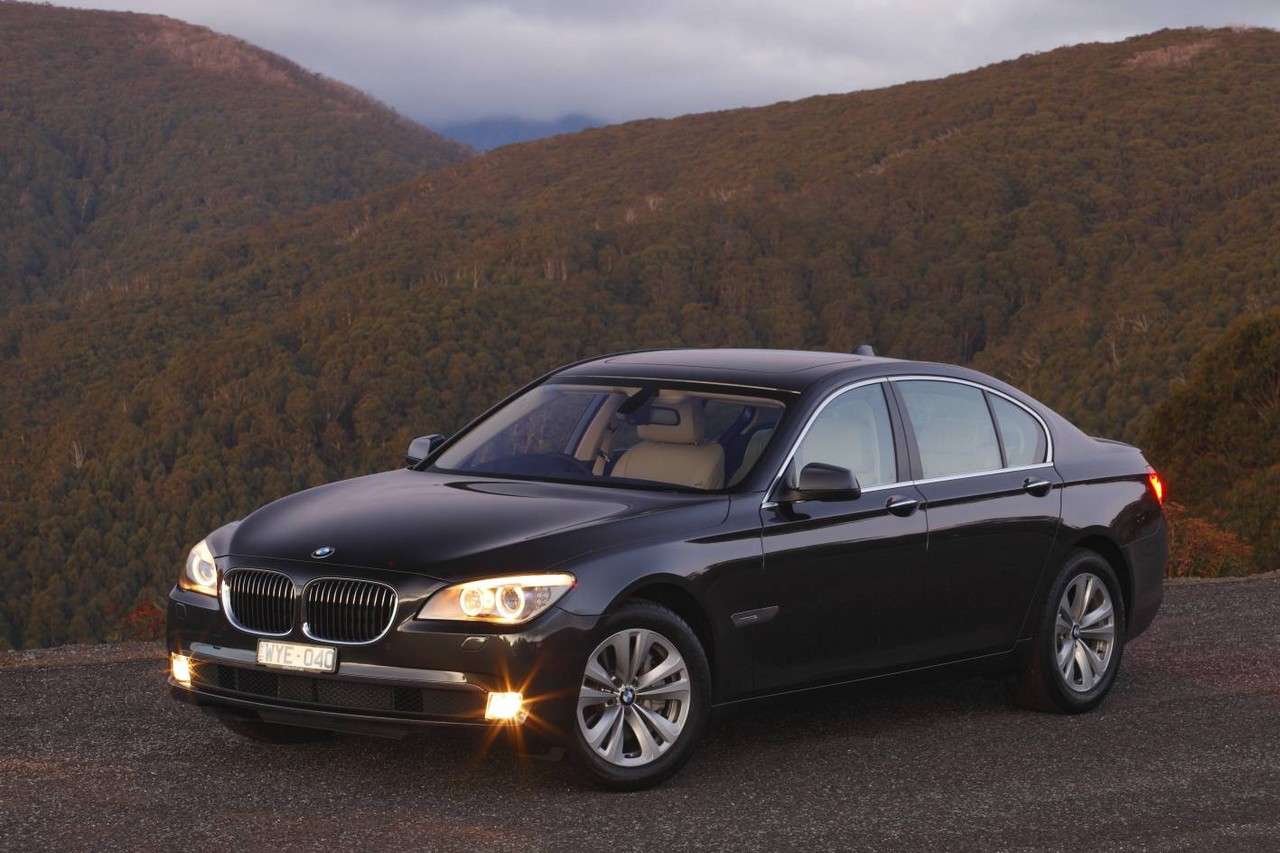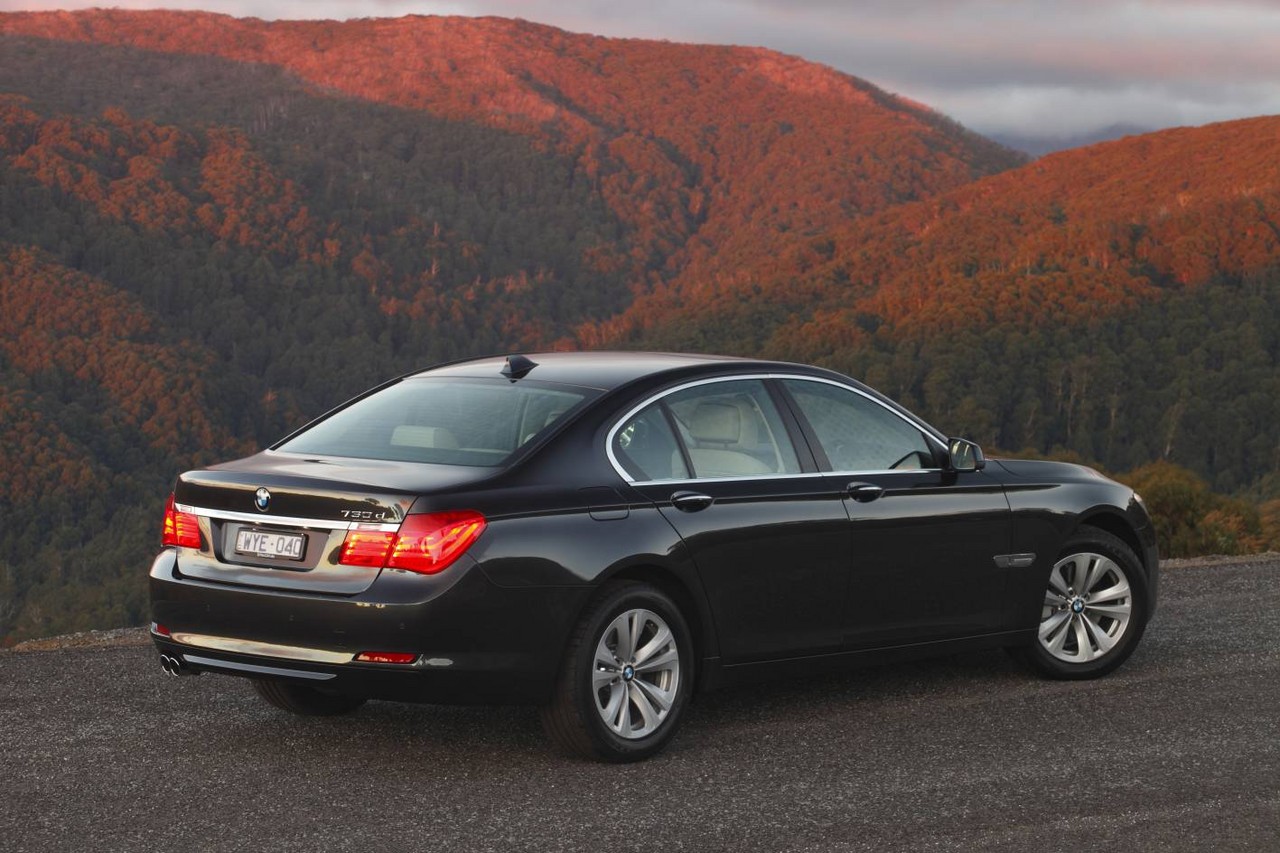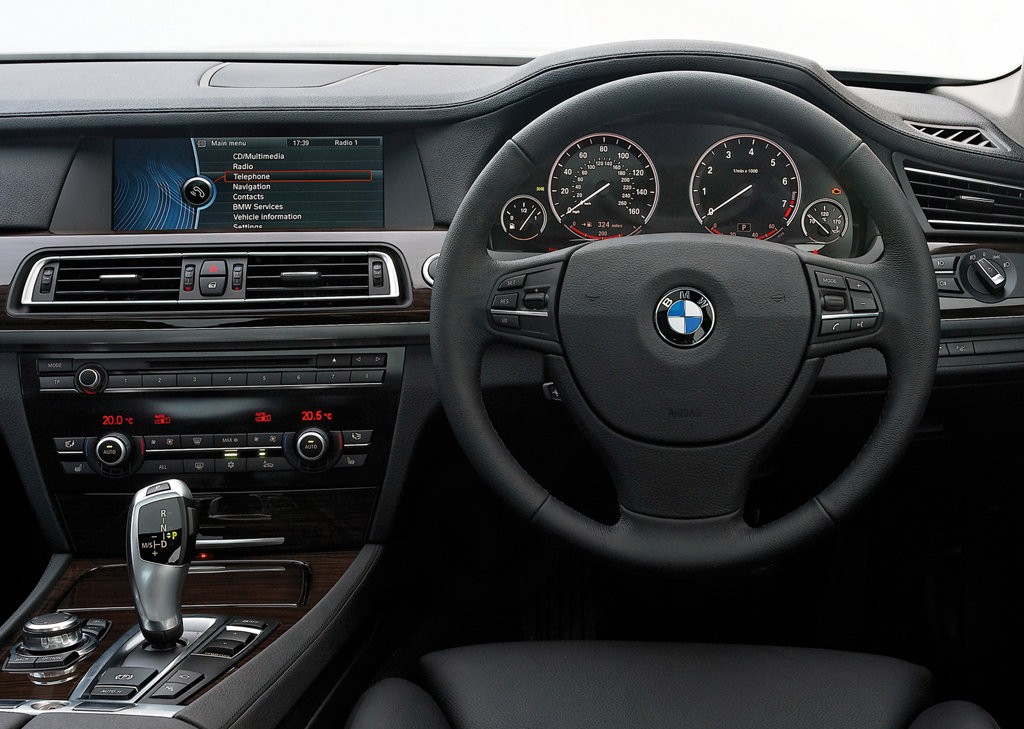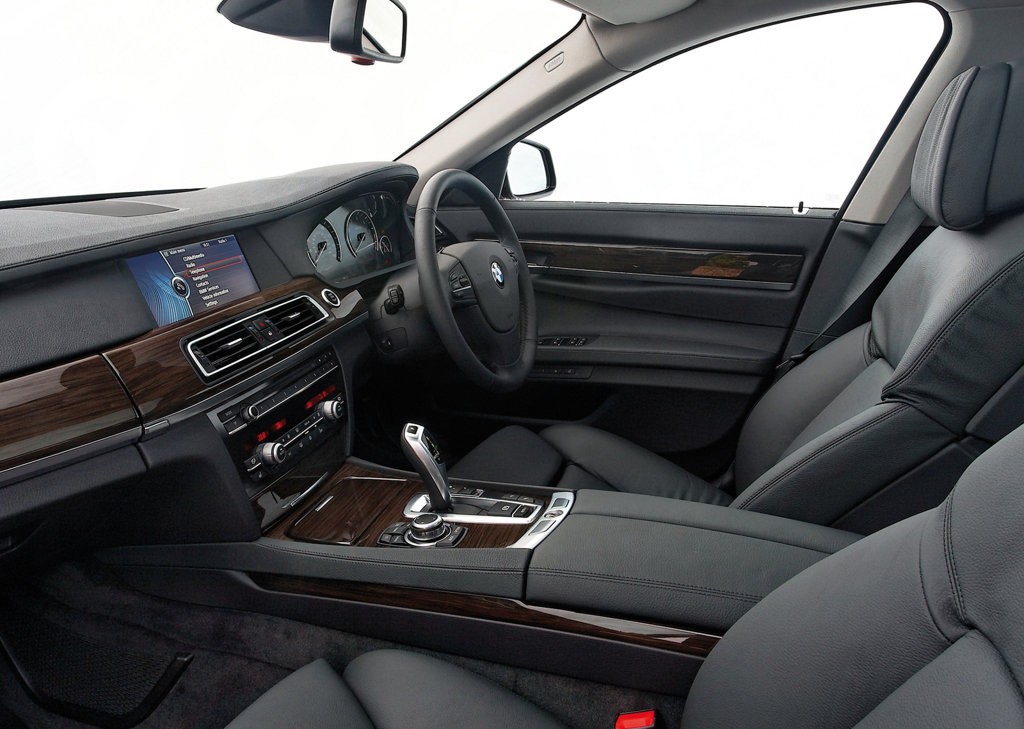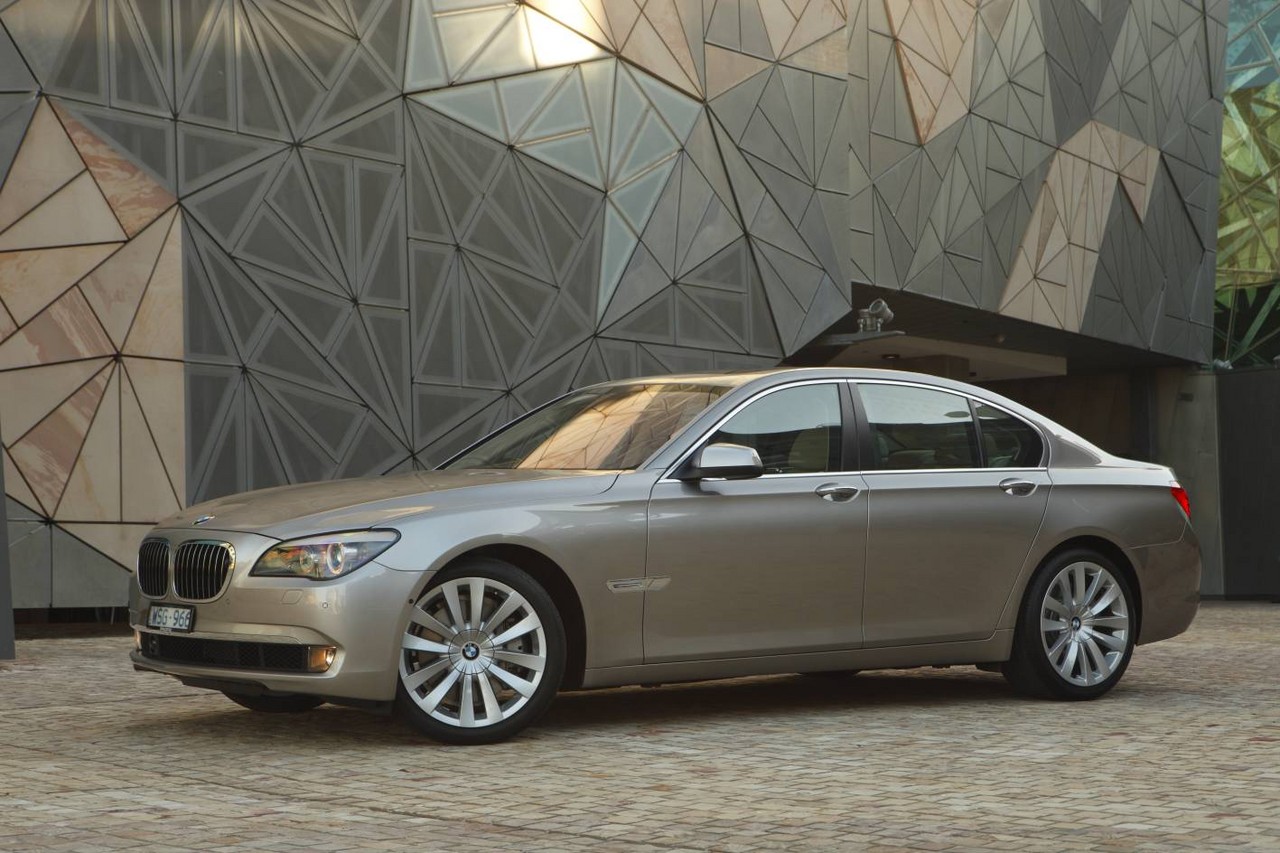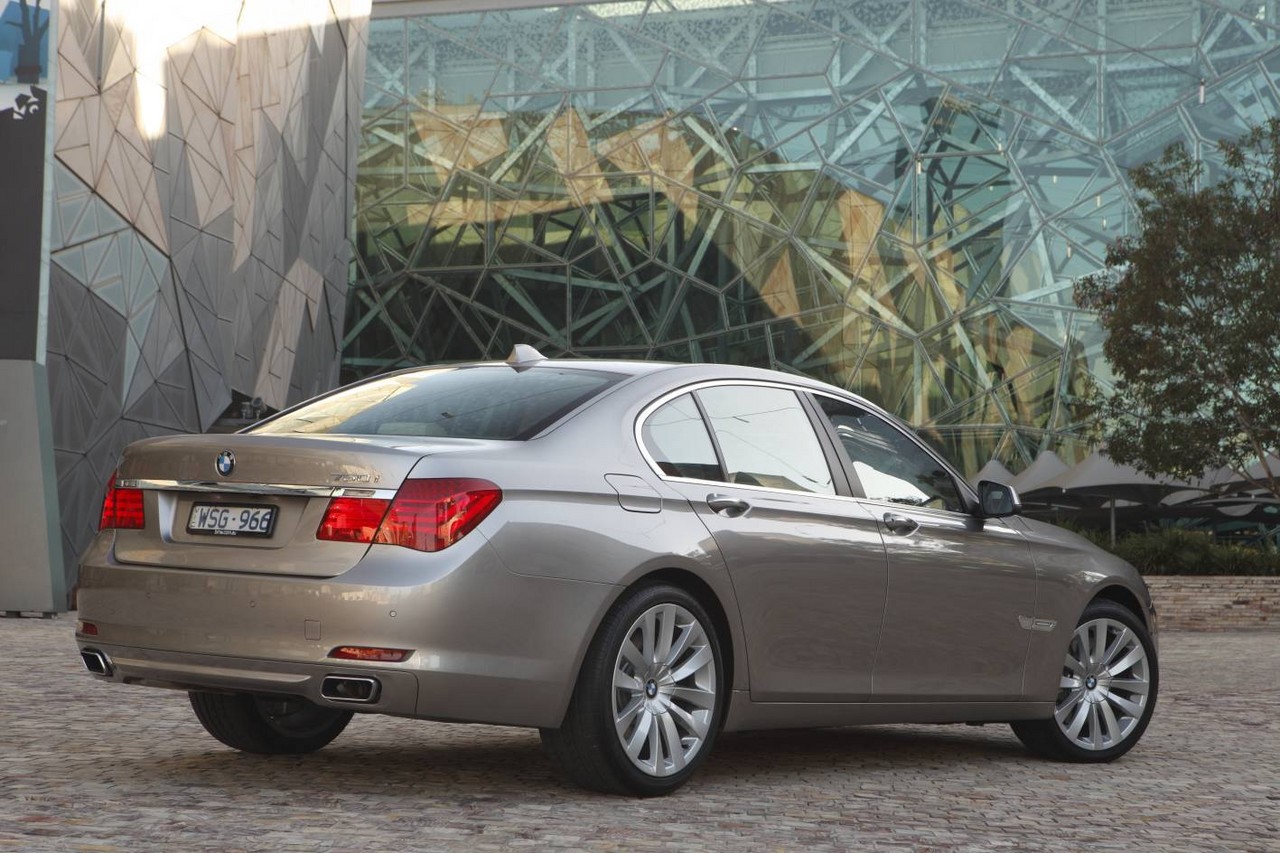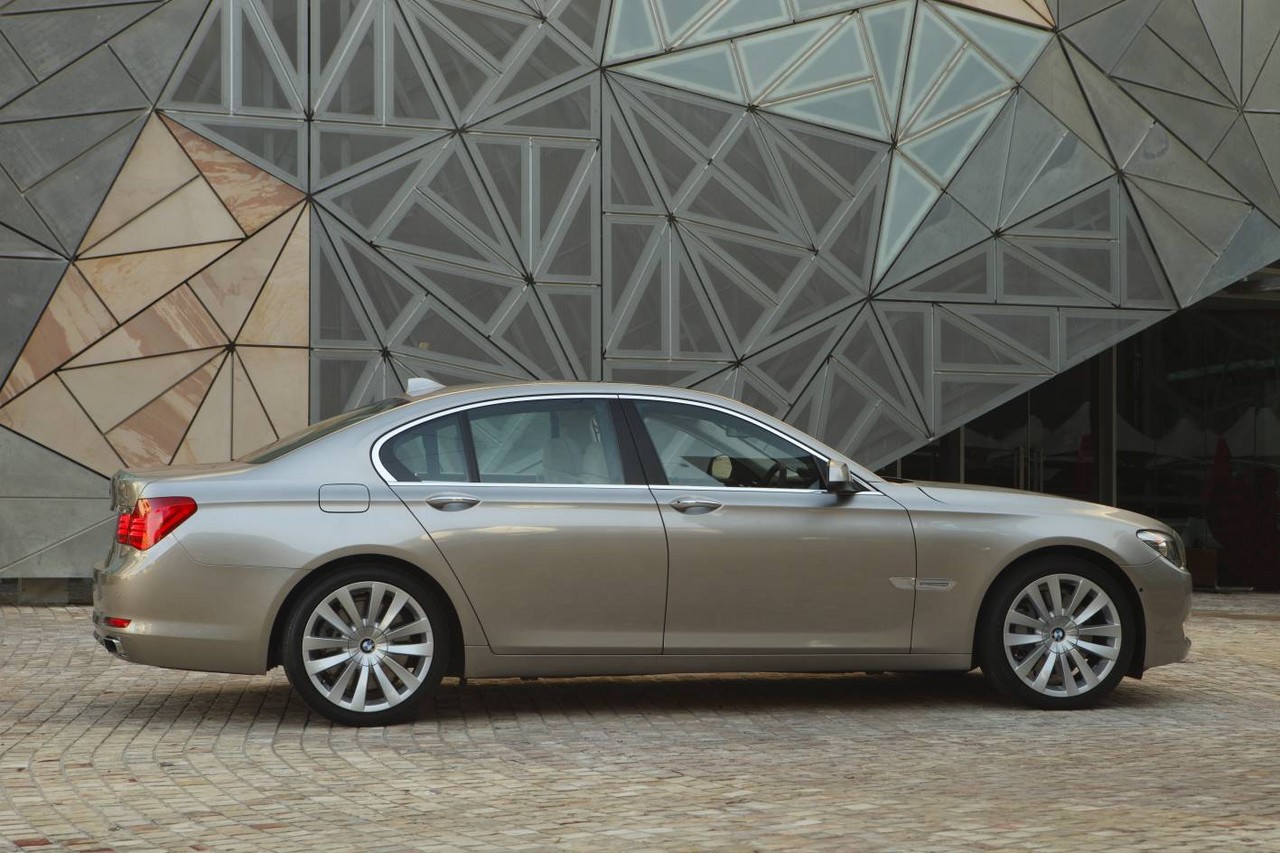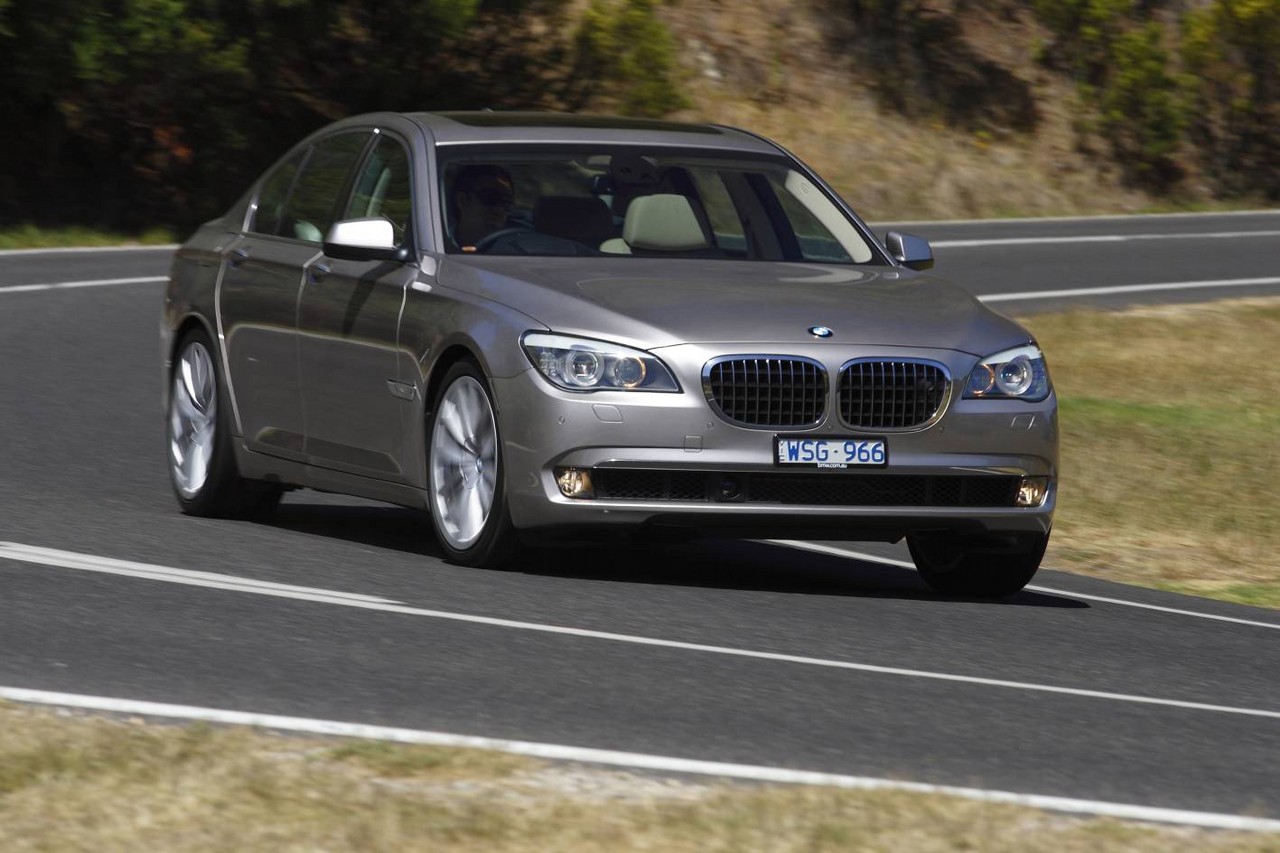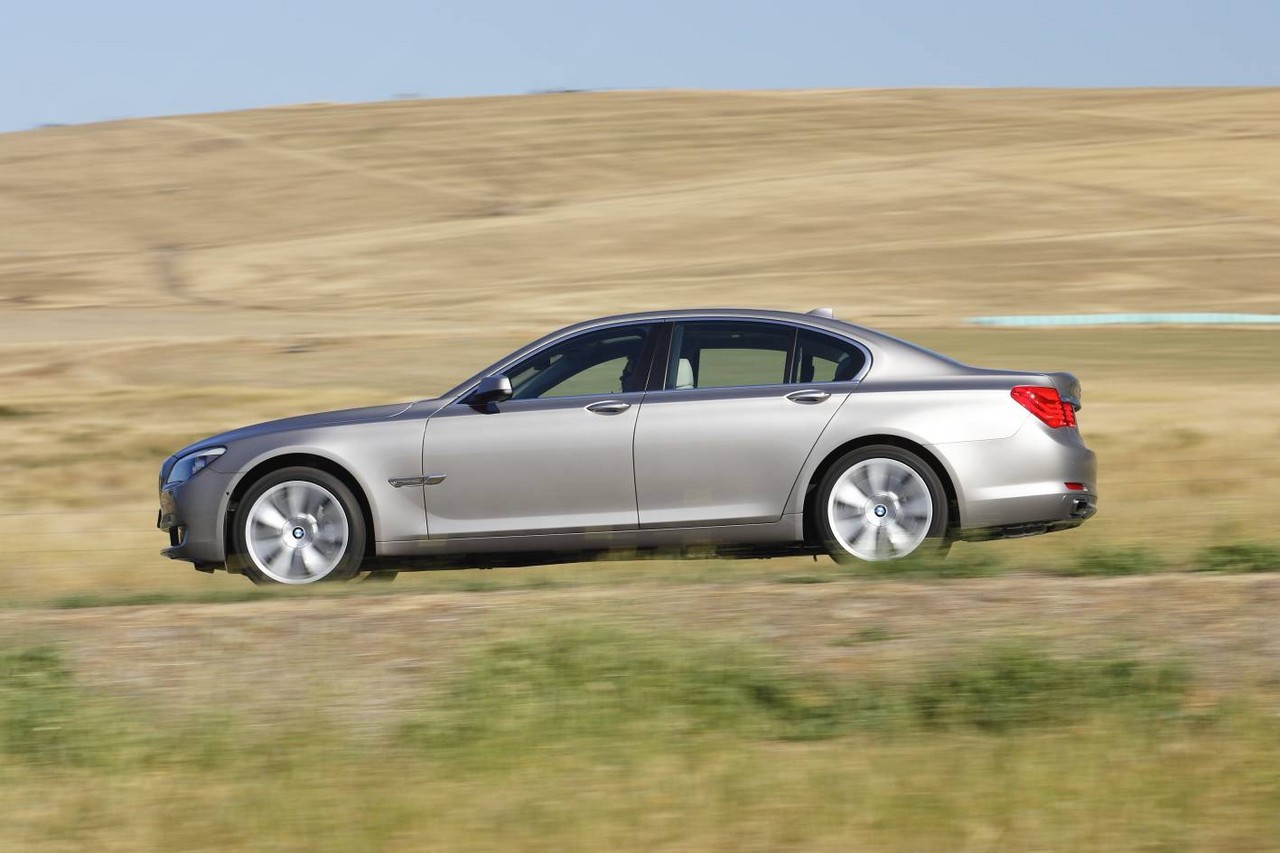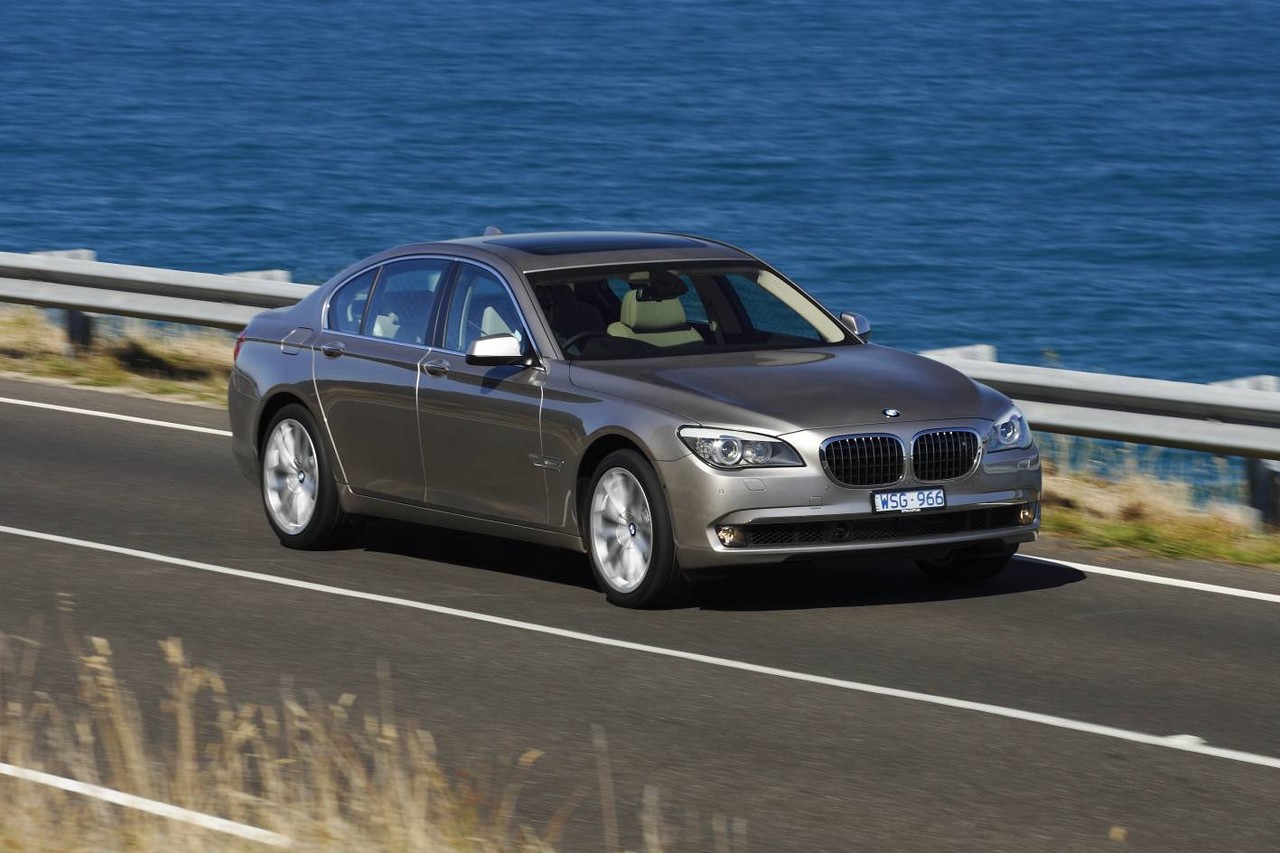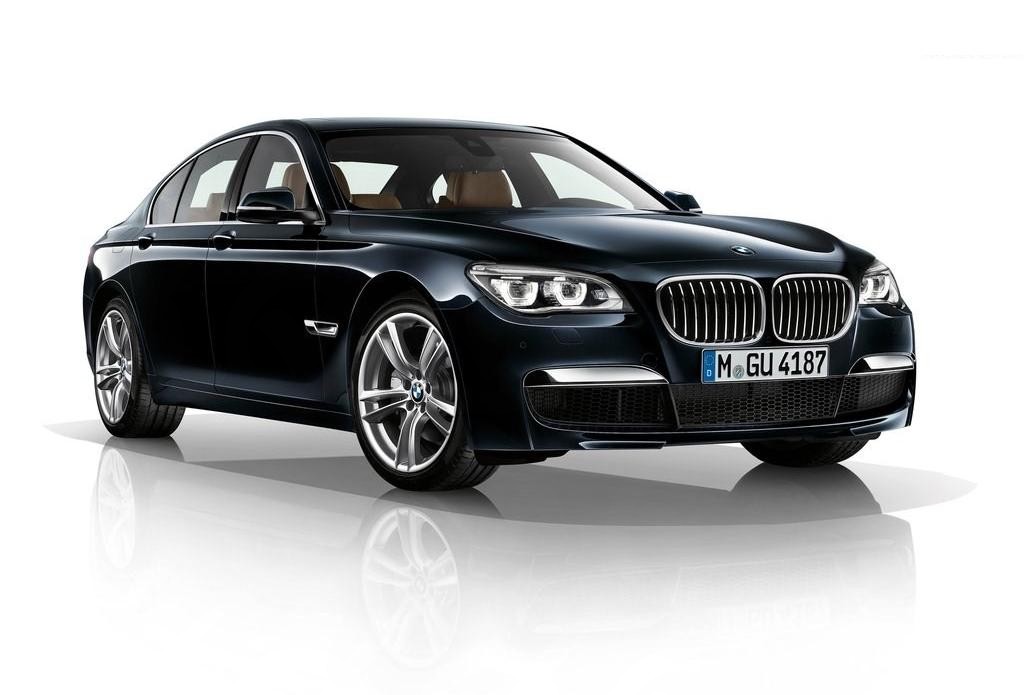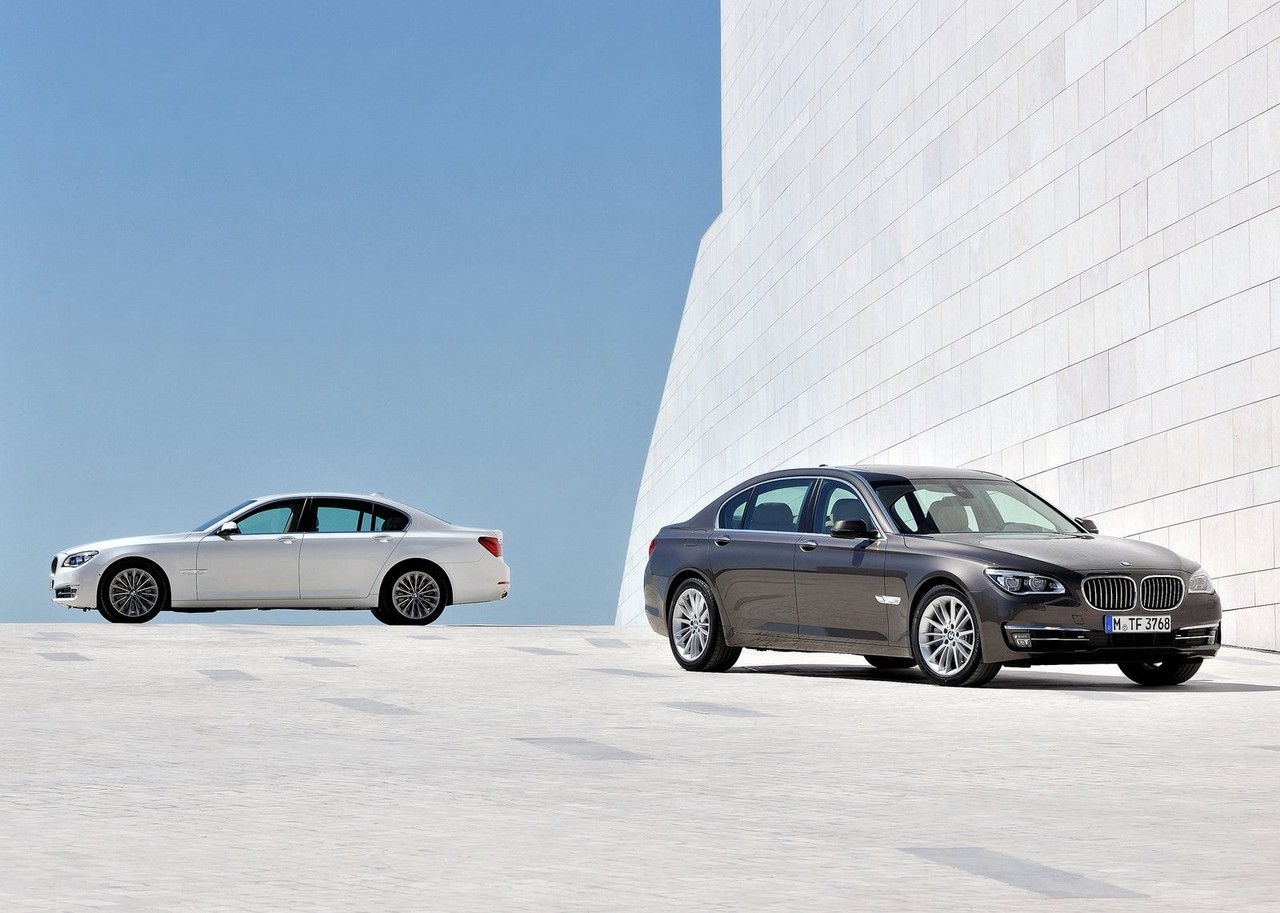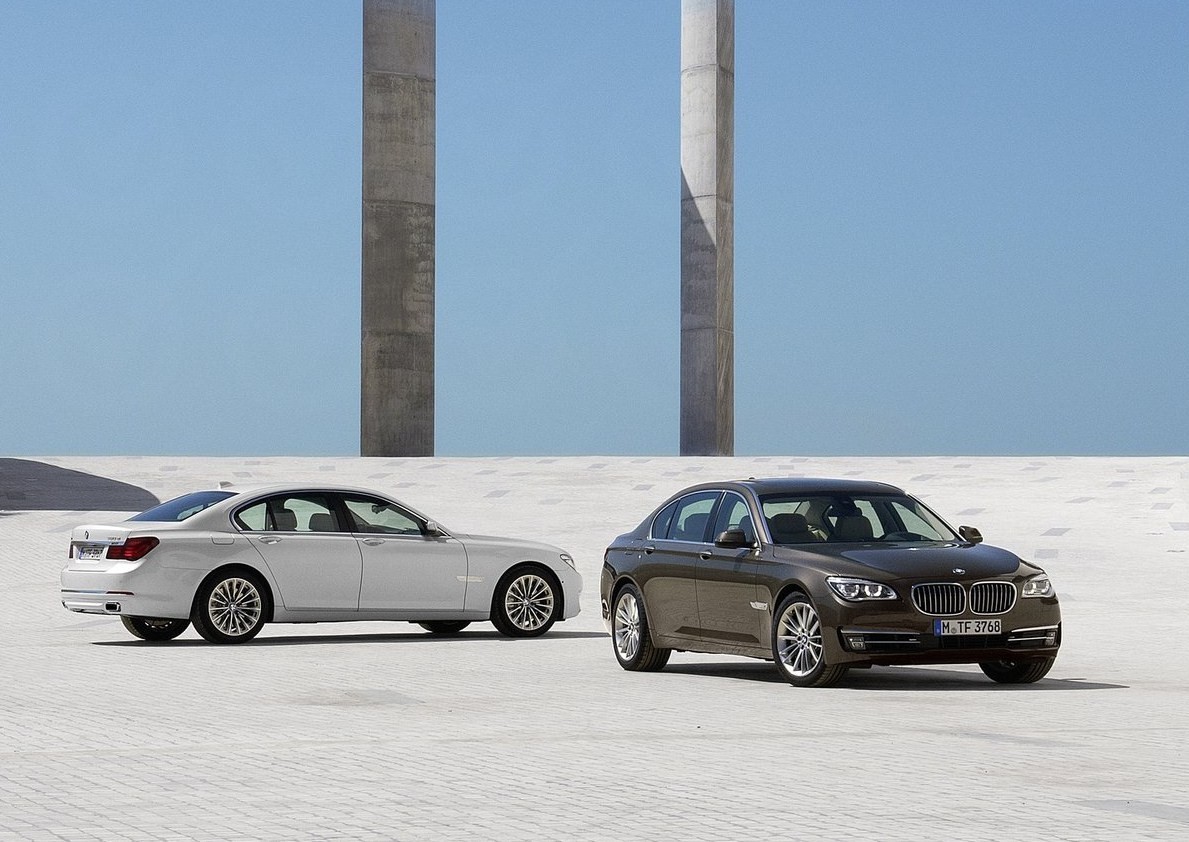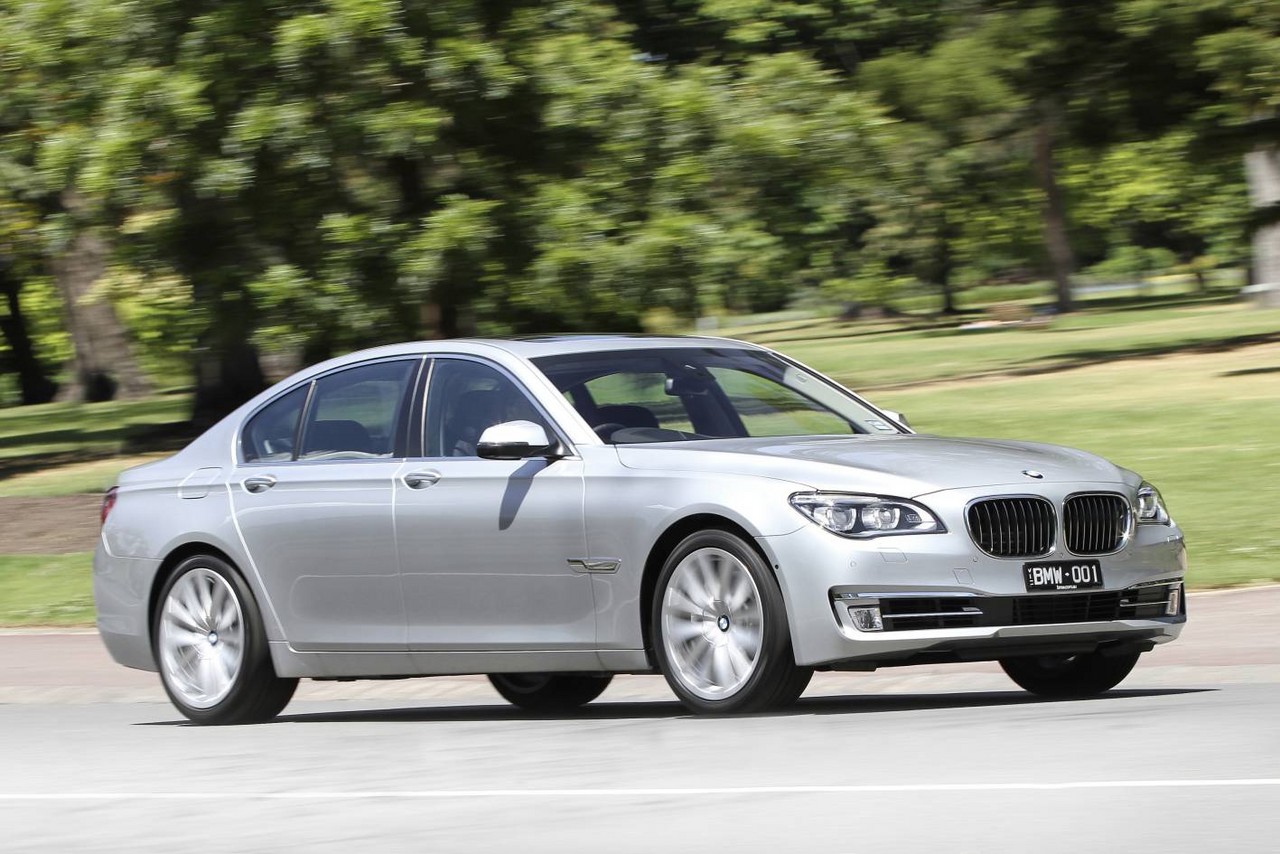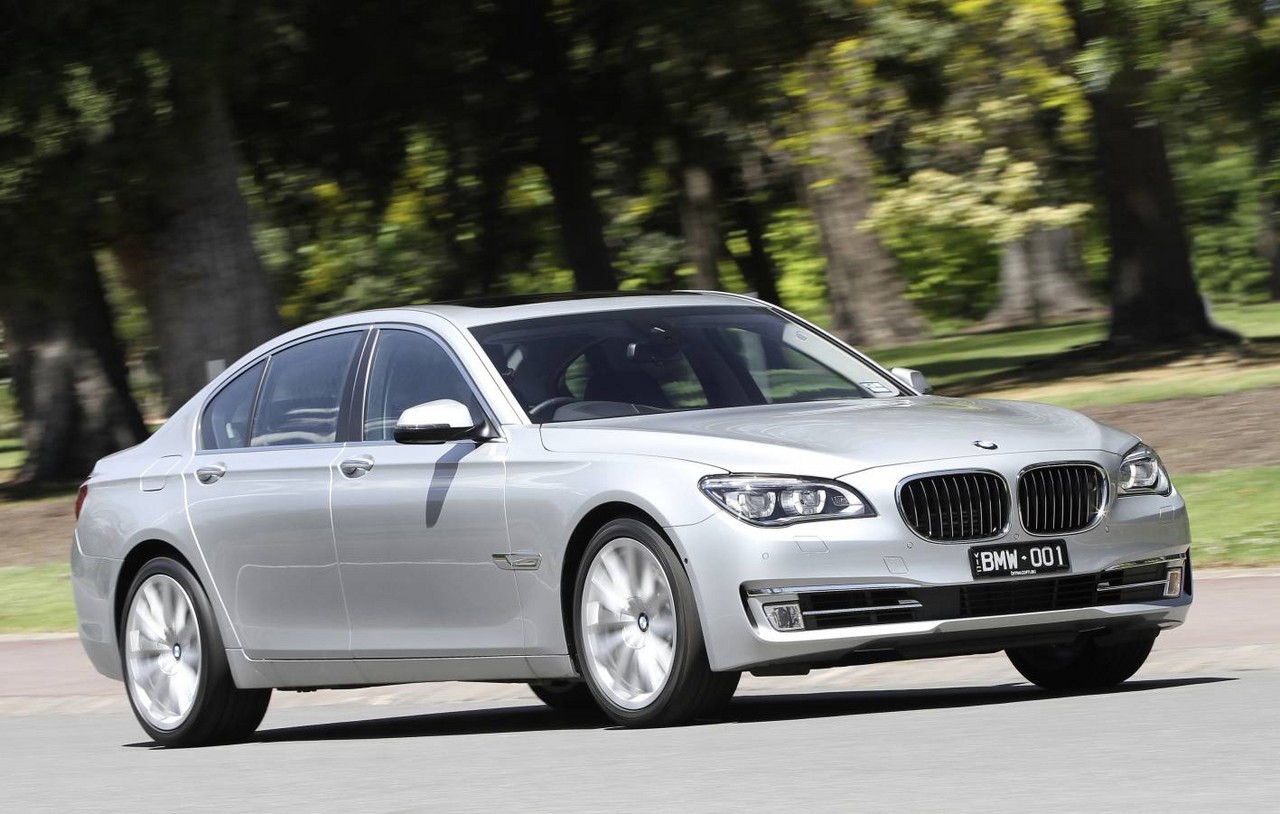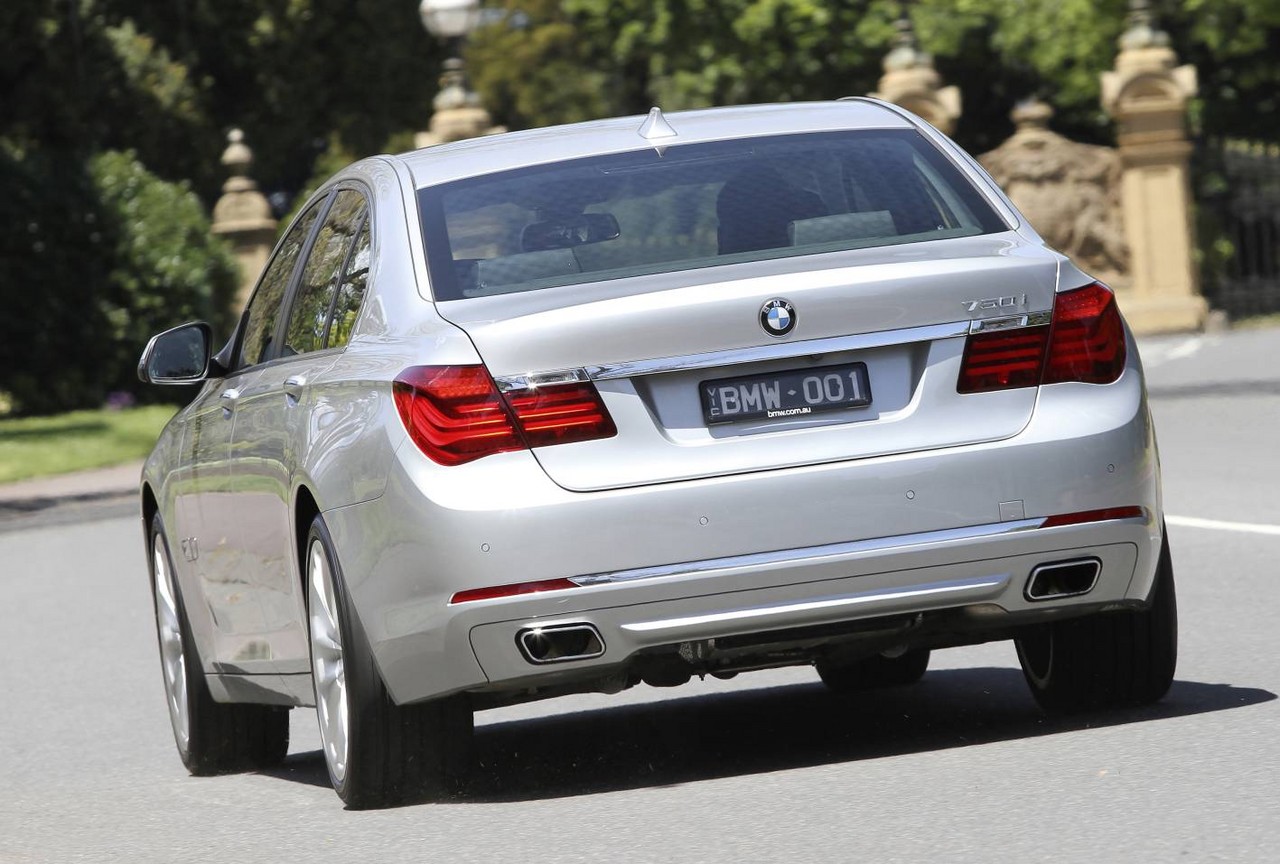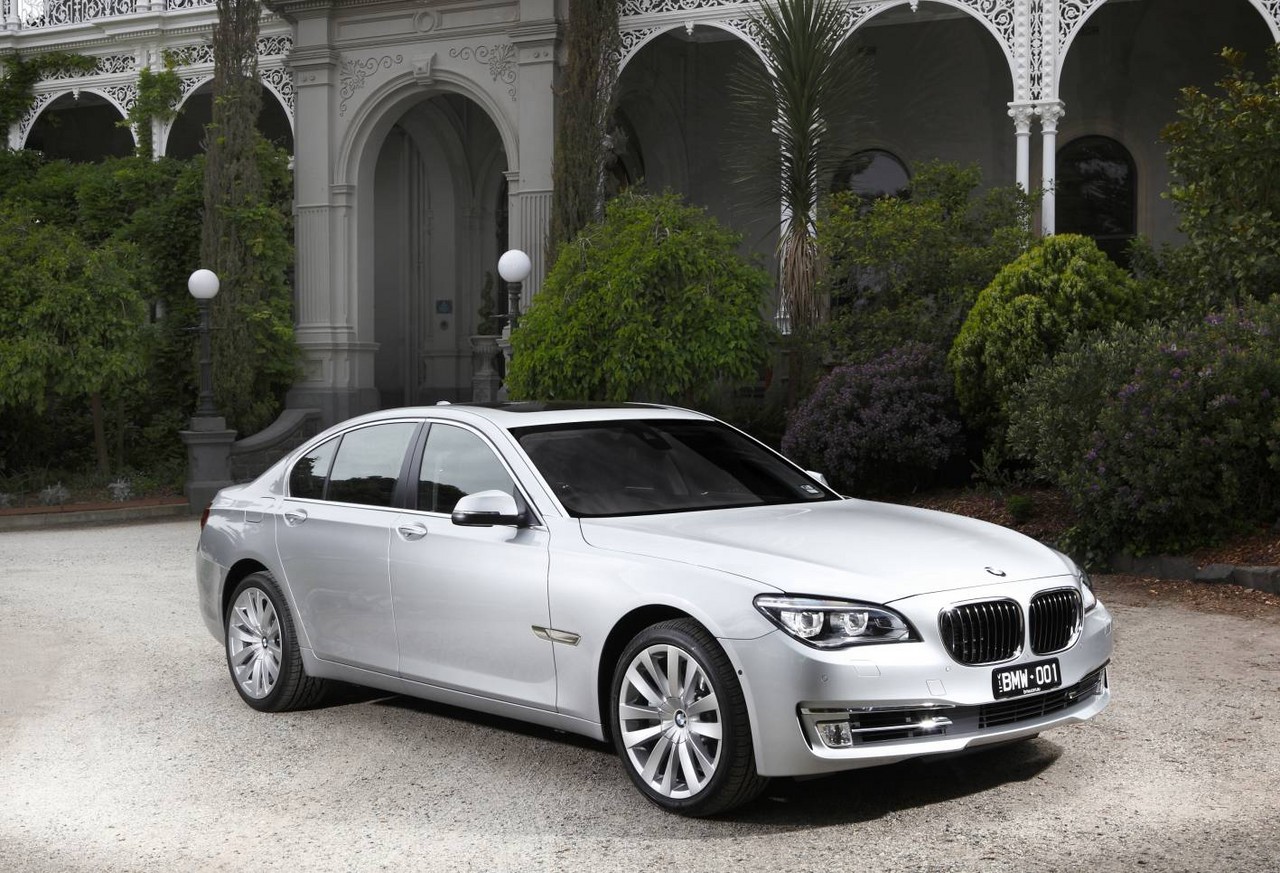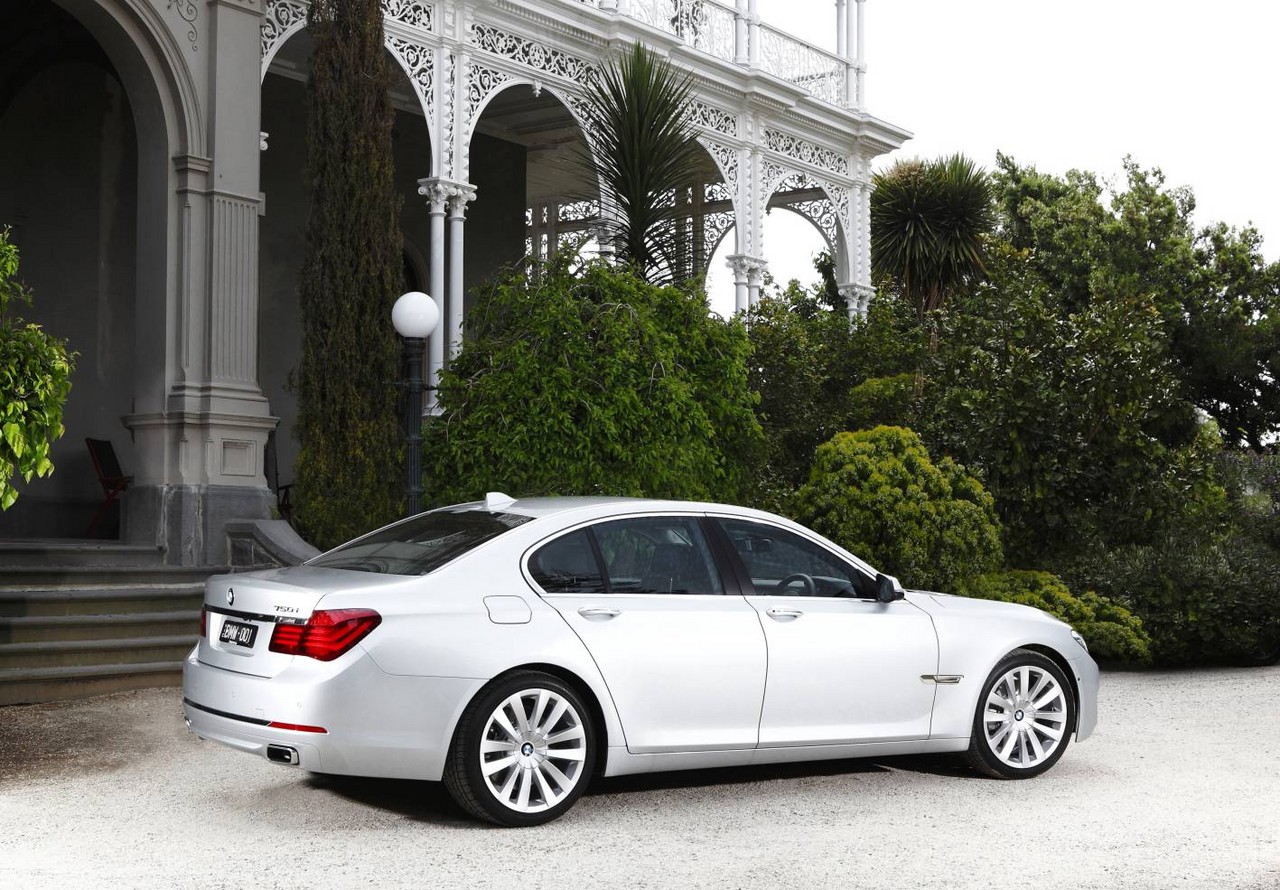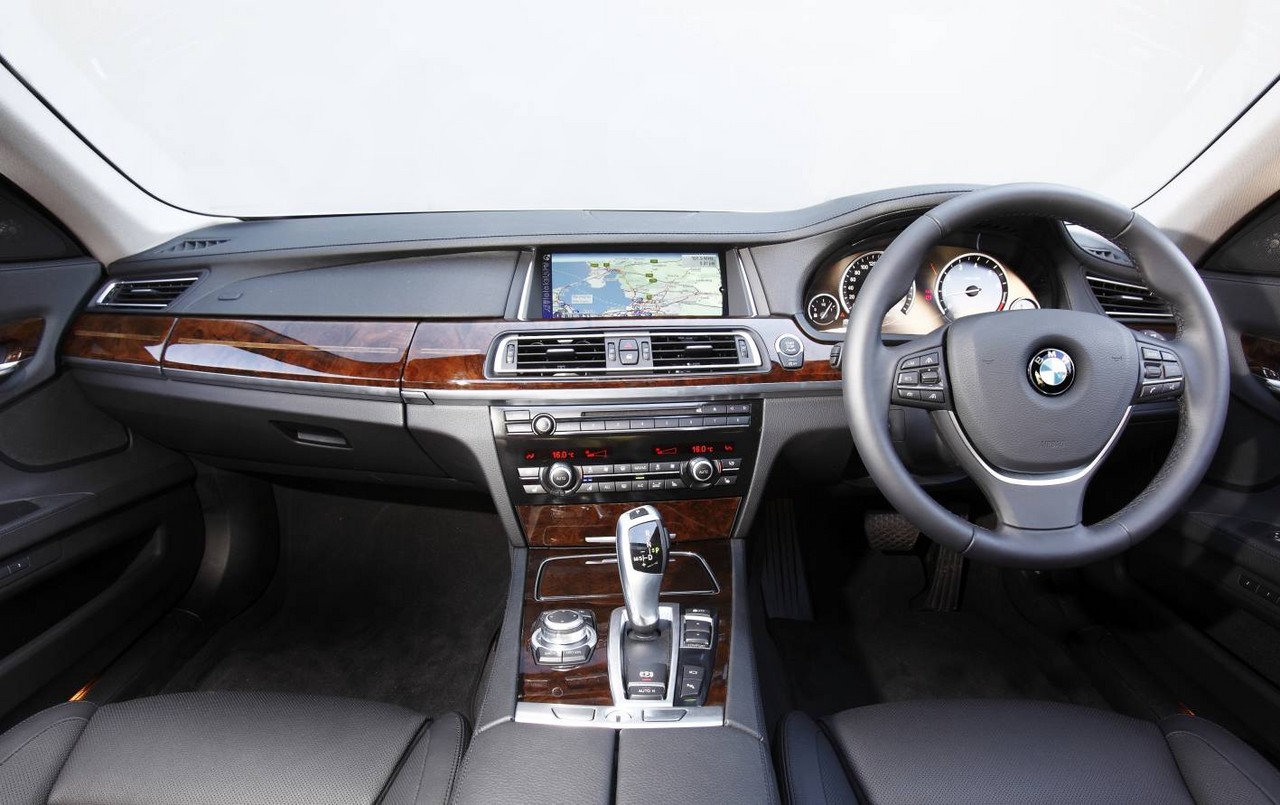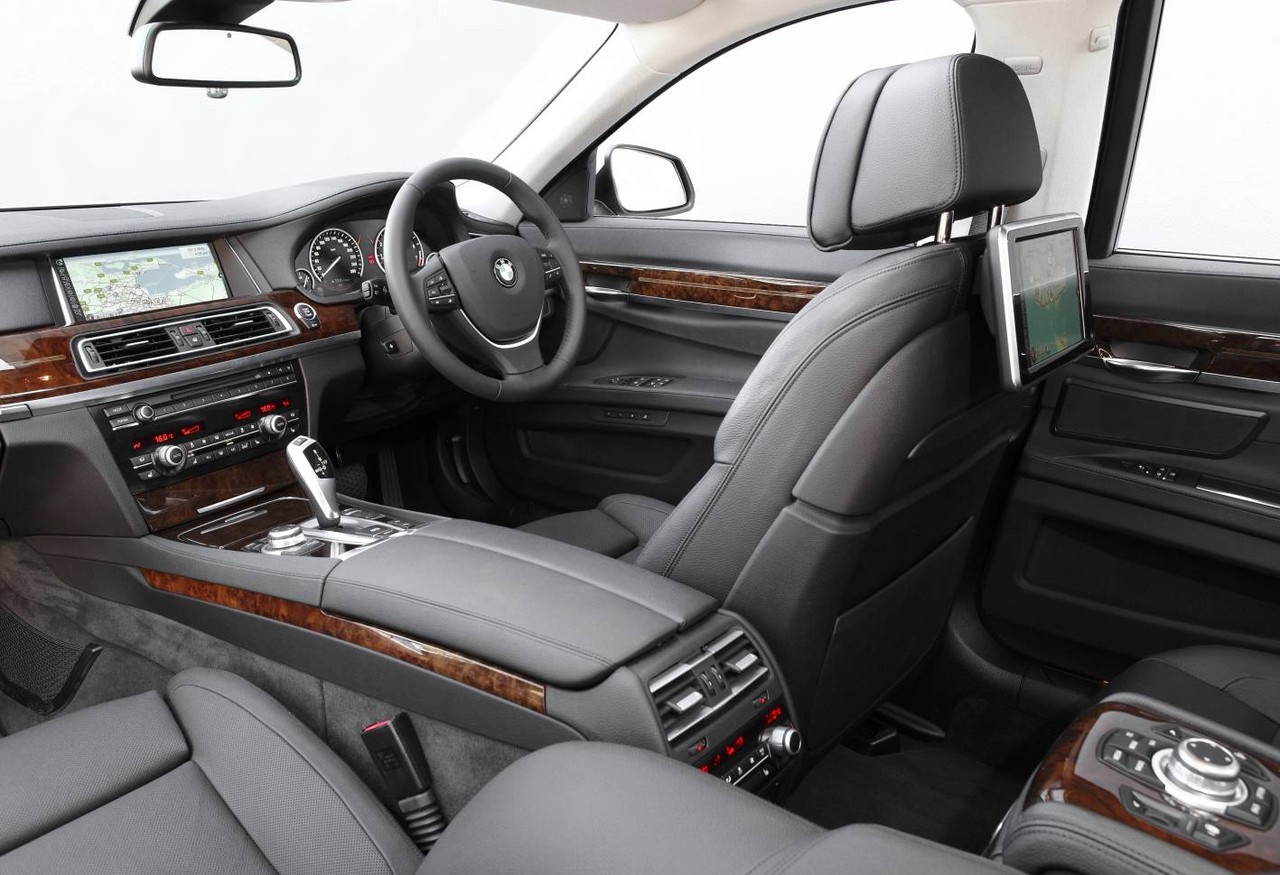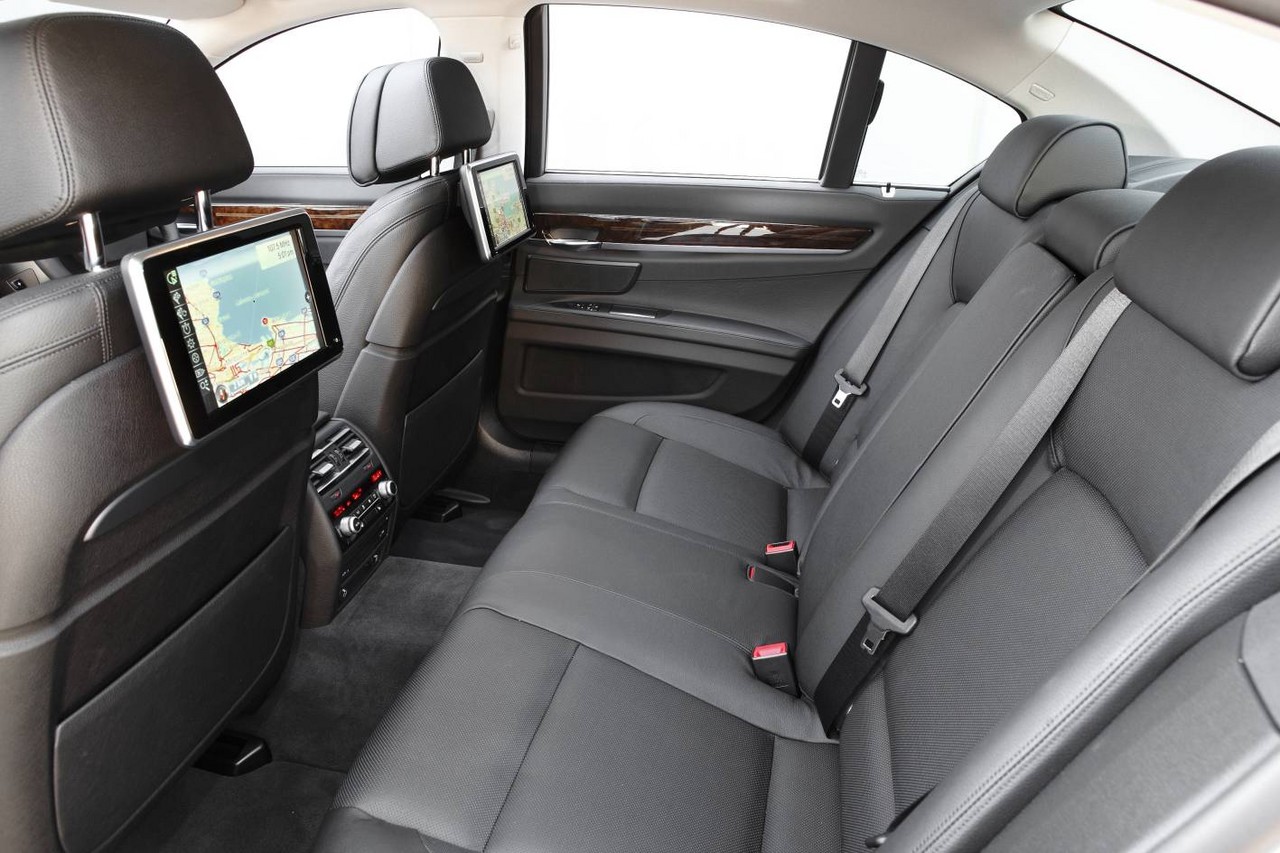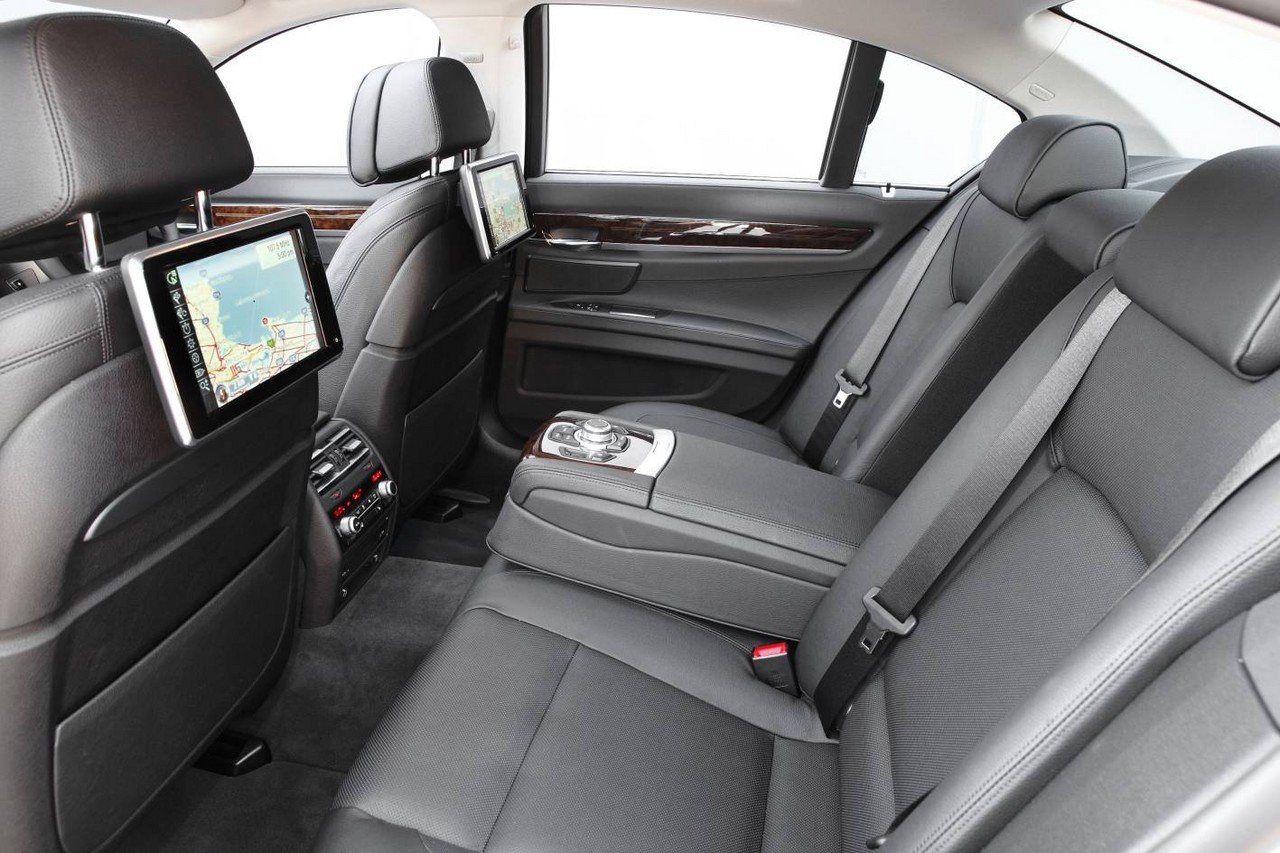
- Powerful twin-turbo petrol engines (V8 and V12)
- Frugal turbo-diesel engine for 730d
- Refined automatic transmissions
- Impressive dynamics
- Comfortable and spacious interior
- Suspension lacks low-speed compliance
- Greater interior noise than rivals
- Lack of steering feel
- High maintenance costs
- Significant and ongoing depreciation
Review: BMW F01.I/F02.I 7-Series (2009-12)
Overview
Released in April 2009, the BMW F01 and F02 Series I (F01.I/F02.I) were luxury sedans with standard and long wheelbases, respectively. Manufactured Dingolfing, Germany, the rear-wheel drive F01/F02 7-Series range initially consisted of the 740i, 740Li, 750i and 750Li models, but was subsequently expanded by the 730d (June 2009) and range-topping 760Li (September 2009).
Compared to the E65 7-Series , the F01 was 43 mm longer (at 5072 mm), the same width (1902 mm), 13 mm lower (1479 mm) and had a 80 mm longer wheelbase (3070 mm). Relative to their F01 counterparts, the F02 7-Series had 140 mm longer wheelbases (3210 mm) and were 140 mm longer overall (5212 mm). The F01/F02 7-Series had double wishbone front suspension and five-link rear suspension.
EfficientDynamics
Of BMW’s EfficientDynamics technologies, the F01.I/F02.I 7-Series had ‘Brake Energy Regeneration’ which controlled alternator output to charge the battery when the vehicle was braking or coasting. In November 2009, a slightly more fuel-efficient version of the 730d was released.
| Engine | Trans. | Peak power | Peak torque | |
|---|---|---|---|---|
| 730d | 3.0-litre turbo-diesel I6 (N57 D30O0) | 6sp auto | 180 kW at 4000 rpm | 540 Nm at 1750-3000 rpm |
| 740i, 740Li |
3.0-litre turbo petrol I6 (N55 B30) | 6sp auto | 240 kW at 5800 rpm | 450 Nm at 1500-4500 rpm |
| 750i, 750Li |
4.4-litre twin-turbo petrol V8 (N63 B44) | 6sp auto | 300 kW at 5500-6400 rpm | 600 Nm at 1750-4500 rpm |
| 760Li | 6.0-litre twin-turbo petrol V12 (N74 B60) | 8sp auto | 400 kW at 5250 rpm | 750 Nm at 1500-5000 rpm |
Safety equipment
Standard safety equipment included dual front airbags, front and rear side airbags, curtain airbags for front and rear occupants, ABS, electronic brake force distribution, brake assist, electronic stability control, traction control, corner braking control, active front seat head restraints and seatbelt pretensioners and load limiters for all seats. The 760Li was also equipped with lane departure warning, lane change warning and active cruise control (with stop and go function).
Features
Standard features for the 730d and 740i included 18-inch alloy wheels with runflat tyres, twelve speaker HiFi sound system with a six-disc CD/DVD changer and auxiliary inputs (MP3/USB/iPod), iDrive system with 80GB hard drive, four zone climate control air conditioning, satellite navigation with 10.2-inch screen, ‘Dakota’ leather upholstery, power adjustable front seats, heated and ventilated front seats, driver and passenger memory settings, cruise control (with downhill braking), head-up display with speed and navigation directions, leather upholstery, ventilated front seats, directional bi-xenon headlights with heated washer jets daytime running function, front and rear fog lights, rear view camera, electronic damper control (with comfort, normal, sport and sport plus settings), front and rear parking sensors, soft-close doors and boot, TV tuner, voice recognition, multi-function steering wheel, remote central locking, automatic headlights, rain-sensing wipers, power windows and mirrors, automatically dipping mirrors when reversing, electrochromatic door and rear view mirrors, proximity key (with BMW’s ‘Comfort Access’), power sunroof, ambient lighting, 12 volt power outlets, a trip computer, an alarm and immobiliser.
Compared to the 730d and 740i, the 740Li added heated rear seats and a ‘Surround View’ camera system which used cameras located each side of the front bumper to enhance visibility and provide a bird’s eye perspective of the vehicle. However, all long wheelbase models were also fitted with self-levelling rear air suspension, ventilated rear seats, rear blinds and independently operated rear seat climate control.
The 750i was further equipped with 19-inch alloy wheels, a 600 watt sound system with sixteen speakers, night vision with pedestrian detection, two 9.2-inch rear screens and ‘Dynamic Drive’ (which sought to reduce body roll by counteracting centrifugal cornering forces); the 750Li added BMW’s ‘Comfort Seats’.
Finally, the range-topping 760Li was distinguished by its 20-inch double-spoke alloy wheels, ‘integral active steering’ (up to three degrees of rear wheel steering), ‘Merino’ leather trim, active front seat bolsters, leather finished instrument panel, alcantara headlining, rear seat massage function and fine-wood inlay leather steering wheel.
7-Series M Sport
From September 2009, the 7-Series was available with an optional M Sports package which included 19-inch double-spoke ‘M’ light-alloy wheels, ‘Dynamic Drive’, leather sports seats, anthracite roof lining, fine-grain aluminium interior trim, an ‘M’ leather steering wheel and footrest, illuminated scuff plates, chrome aprons and a sports bodykit.
Related links
- Press Kit: BMW F01.I/F02.I 7-Series (September 2008)
- Press Kit: BMW F01.I/F02.I ActiveHybrid 7 (August 2009)
Review: BMW F01.II/F02.II 7-Series (2012-15)
Overview
Released in November 2012, the F01 and F02 Series II (F01.II/F02.II) 7-Series introduced eight-speed automatic transmissions across the range, cosmetic updates and mechanical upgrades. Furthermore, all models other than the 760Li were fitted with Auto Start/Stop – which enabled the engine to shut down when the vehicle was stationary in traffic – and an Eco Pro driving mode to minimise fuel consumption.
Visually, the F01.II/F02.II 7-Series could be identified by its adaptive LED headlights, kidney grille with nine vertical slats (previously twelve) and larger chrome surround, three-section lower grille with chrome bars, a chrome strip between the rear reflectors in the rear apron and dark-lens tail-lights. Inside, the F01.II/F02.II 7-Series had thinner front seats, an updated Professional navigation system and extended black-panel technology that displayed different information for the Comfort, Eco Pro or Sport driving experience modes.
The F01.II/F02.II 7-Series introduced a new electronically controlled damping system whereby the dampers were adjusted at each wheel individually according to the condition of the road surface and driving style. As such, the compression and rebound settings were adjusted continuously and independently from one another. Furthermore, greater ride comfort was provided due to modified rubber bearings, new dampers and self-levelling air suspension for the rear axle, the latter fitted as standard across the range (previously reserved for long wheelbase models). Other changes included the introduction of an electric power steering system and additional soundproofing in the B- and C-pillars, skirts and boot area for greater refinement.
ActiveHybrid 7
In early 2013, the 7-Series range was expanded with the introduction of the ActiveHybrid 7. The ActiveHybrid7 had the same 3.0-litre twin turbo six-cylinder petrol engine and eight-speed transmission as the 740i, but was also fitted with a 40 kW synchronous electric motor and lithium-ion battery. As such, the ActiveHybrid 7 could drive up to 4 km on electric power only, though the maximum top speed using electric power only was 60 km/h.
| Engine | Trans. | Peak power | Peak torque | |
|---|---|---|---|---|
| 730d | 3.0-litre turbo-diesel I6 (N57 D30O1) | 8sp auto | 190 kW at 4000 rpm | 560 Nm at 1500 rpm |
| 740i, 740Li |
3.0-litre turbo petrol I6 (N55 B30) | 8sp auto | 235 kW at 5800 rpm | 450 Nm at 1300-4500 rpm |
| 750i, 750Li |
4.4-litre twin-turbo petrol V8 (N63 B44TU) | 8sp auto | 330 kW at 5500 rpm | 650 Nm at 2000-4500 rpm |
| 760Li | 6.0-litre twin-turbo petrol V12 (N74 B60) | 8sp auto | 400 kW at 5250 rpm | 750 Nm at 1500-5000 rpm |
| Active Hybrid 7, Active Hybrid 7L |
3.0-litre turbo petrol I6 (N55 HP) | 8sp auto | 235 kW at 5800 rpm | 450 Nm at 1500-4500 rpm |
| Synchronous electric motor | 40 kW | 210 Nm | ||
| Combined | 260 kW | 500 Nm | ||
Safety equipment
Compared to their F01.I and F02.I predecessors, standard safety equipment was extended to include an ‘Attentiveness Assistant’ which monitored driver behaviour for signs of fatigue and provided a warning.
Features
Standard features were extended to include adaptive LED headlights and an automatic boot opening function; standing behind the vehicle with the key fob on their person, owners would only need to move their foot under the centre of the rear bumper to unlock and automatically open the boot.
For the 750i, 750Li and 760Li, the Night Vision system was upgraded to include a Dynamic Light Spot function to improve early pedestrian detection (up to 100 metres away) and pinpoint the detected pedestrian.
The ActiveHybrid 7 and 7L were comparably equipped to the 740i and 740iL, respectively.
Related links
- Press Kit: BMW F01.II/F02.II 7-Series (July 2012)
- Specifications: BMW F01.II/F02.II 7-Series (November 2012)
- Specifications: BMW F01.II/F02.II 7-Series (April 2014)
- BMW Australia: BMW 7-Series
- Wikipedia.org: BMW F01 7-Series
